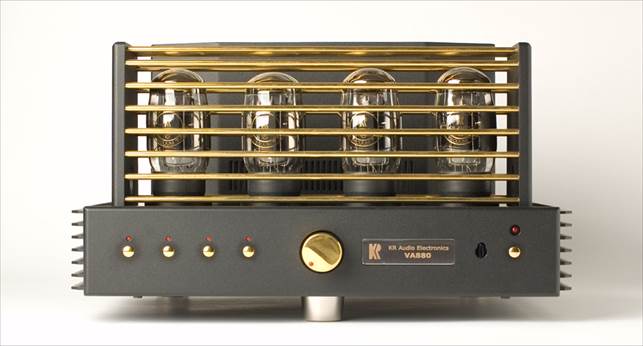For those unable to accommodate the mighty Kronzilla
valve amplifier, KR Audio offers something more domestically acceptable in the
form of the KT88-equipped VA880
While the resurgence of vinyl is becoming a more and more
familiar story, there is another area of the audio industry that's equally
buoyant: the rebirth of the valve amplifier. There is ample choice for the
prospective buyer at all price levels, and the KR Audio VA880 sits perfectly in
the middle ground - not too small and feature-limited, but equally not too big,
exotic or priced permanently out of reach.
KR Audio will be a familiar name to readers thanks to John
Bamford's review of the jaw-dropping Kronzilla SXi. This unit is a real labour
of love, featuring unique valves designed by the company itself, but its size
and price will restrict it to a lucky few. The VA880 is, however, an altogether
more practical proposition, as it's based around the well-proven, and popular,
KT88 valve.

KR Audio VA880
front view
Interestingly, KR Audio doesn't actually manufacture these
valves; those fitted to the review amplifier were Genalex Gold Lion types from
Russia.
The $8,600 UK price tag sported by the VA880 pitches it
somewhat above the price of many well-known valve models by the likes of Ming
Da, Icon Audio and Prima Luna, but it does have some competition, including
models boasting 211, 300B and 845 valves from Melody, plus the KT120- equipped
Jadis I35.
The amplifier itself is a neat design and, while not
abounding with stylistic flourishes or undue bling (thank goodness!), it is a
beautifully made unit and the matt finish of most of the metalwork lends it an
undeniable ‘brutalist' charm.

With the power and
output coupling transformers encased in a steel box above, KR Audio’s
logic-controlled inputs, PSU smoothing, FET driver amp and volume are housed
beneath
Front panel controls are limited to four unlabelled source
selection switches that relate to the corresponding range of inputs on the rear
panel. At the right-hand end is a fascia standby switch that operates in
conjunction with the main power switch on the rear panel. The remote control window
and centrally placed volume control complete the picture.
Inverted topology
At the rear, things are a little more crowded, with inputs
via three pairs of phono inputs and one pair of balanced XLR sockets - all
analogue. Input selection is achieved using reed relays and the signal is
subsequently fed into a Class A MOSFET driver section and on to the variable-bias
tube output stage.
The topology of the amplifier is the opposite to the common
idea of a hybrid design, which usually involves a thermionic preamplifier
driving a solid-state power amplifier. However, as is so often the case in
audio, it's less a matter of how it's done, but more how well it's done, and so
the apparently topsy-turvy layout of the VA880 should in principle offer no
issues, especially coming as it does from a company that knows its power
valves.

KR Audio VA880 in room
On the output side of things, settings for 4ohm and 8ohm
loudspeakers are offered, but rather than simply fitting different binding
posts for each, KR Audio has chosen to equip the VA880 with a single set of
posts per channel. So it is necessary to remove a small panel on the
amplifier's rear and redistribute four small screws underneath according to the
guide on the underside of this panel. While this is not a problem in itself, my
one small concern was that the 4ohm setting uses four screws, but the 8ohm
setting only requires two. I'm sure I am not the only person that can foresee
those two extra screws having disappeared the very day one purchases a new pair
of loudspeakers and finds a need for them!
A small, nicely made remote control handset is supplied with
the amp, and this is a boon as the metal volume knob on the fascia is right
under the output valves and becomes quite hot after some hours' use.